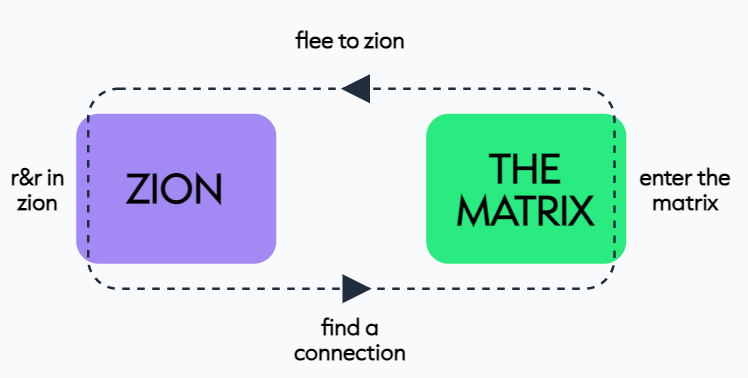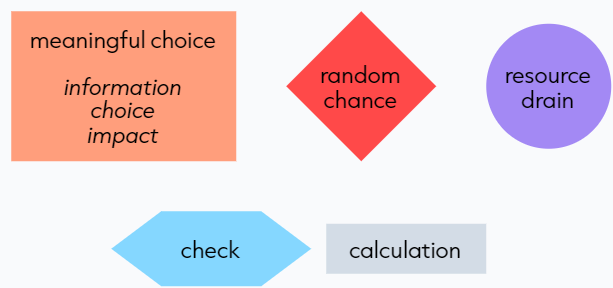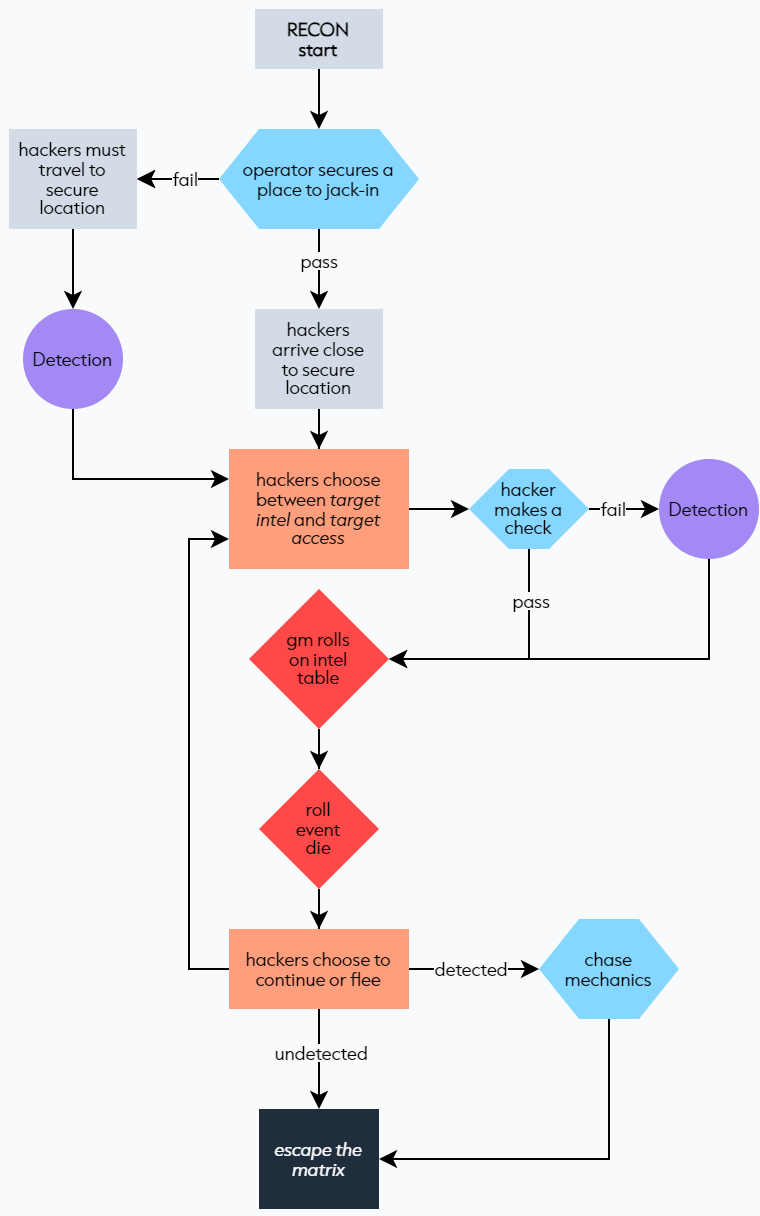Apologies for the bit of the delay in getting part two out the door. I’ve been swamped lately with editing Barkeep on the Borderlands and the blog is the first thing to suffer. This adventure is going to be amazing, though.
The previous post in this series laid out the groundwork of what we’re trying to do here: build a set of procedures, unconnected to ‘system’, that let us play an RPG campaign that has the vibes and structure of The Matrix movies.
To do that we’re focusing on building out four core procedures that will serve as the engine that propels the game. To recap, the four procedures that make up the loop are:

In part one we worked on finding a connection and getting our hackers ready to jack in. There were a few great comments from readers that I’ll address now:
Ryan Chandler muses a bit about the quiet times:
“How could you expand this part of the game?”
I would want to add in two things: scenery of a ruined earth, and getting to know your crewmates. You mentioned zone specific results for connection generation as baked in world-building, and I latched on to that. I always wanted to know more about the ruined earth and what the machines have built with it in those movies and think it would be a blast to just add in little details, for example, a “Former Great Lakes Region” where all of the water has been captured in massive waterworks that utilize it for cooling or industrial projects. Connection sites might have a whole different set of risks involved, perhaps even requiring modifications to the hovership so it can operate in wet environments.
While you mentioned R&R back in Zion, my initial reaction is to imagine that as time apart from the crew. Afterall, you’re stuck with them on a small ship, right? So this section of finding and travelling to a connection might be where crew connect and share hopes, fears, ambitions, and secrets. Maybe a table of events where crew might share their changing emotional state - perhaps allowing chaos to introduce a character beginning to wish they had taken the blue pill?
Just thought I’d throw my two cents out there! I’ve been more and more interested in using procedure and loops to organize game creation, and this post is really illuminating how useful these tools can be.
I really like both points. Scenery of a ruined earth slots in easily to the Event Die, so that’s where I’d immediately put that. With R&R back in Zion, the idea of expanding this part of the game and allowing you to form bonds with other crewmates is great. One thing that popped into my head is that you might form bonds with your crew while outside of Zion, but when you return for R&R you can harden those bonds into something permanent. What does all of this mean in game mechanical terms? I have no idea! This isn’t a game system, it’s a theory on how to run Matrix games with any system.
Are you trying to show me how to make a Matrix system?
No, Neo. I’m trying to show you that when you’re ready, you won’t have to.
John Mauney brings up a good point:
One thing that matters is a procedure’s end state(s). What happens when they run out of fuel or the hovercraft sustains too much damage? These examples would make for different feeling games, I think:
- The party is lost, make a new party
- Emergency power kicks in; the party must immediately return to Zion or some other charging/repair station they’ve previously located
- The ship powers down and must remain still long enough to absorb enough latent power/jury-repairs to return to Zion; roll on the events table N times.
- Roll on a special random table to detemine what happens
I really like this, and John has provided some great examples that fully change the vibe of the game. I do like the idea of the first and third bullet points a lot—the first because then you get to go rescue your regular party with a backup party, and the second because it means you can really press your hovercraft to keep going if you need to, but at relatively high risk to the crew.
Beloch Shrike asks how fertile the real world is as a play space:
I’d be curious if the real world of the matrix could be made into an interesting adventure space without losing the sense of frailty that is essential to it in the film. The only effective move humans seem to have is an EMP blast, which takes time to charge, and if used in any but the most ideal circumstances will can be just as harmful to the humans as it is to the machines.
Is a travel encounter with machines interesting if the only move is “We land and use the EMP.”
Does the game feel like the matrix if there are any other moves to make?
I would add that the humans do have one other move: they have huge lightning guns that shoot lightning and can take out one sentinel. So a couple of humans could conceivably take on a sentinel or two in a pinch. In The Animatrix, there are a group of humans that are working to free machines instead of humans, and in those cases the machines end up fighting against other machines (in the real world) to help save the fragile little meatbags. We also see this in the newest Matrix movie, albeit only briefly and basically as an afterthought.
I think the answer is here two fold:
- The travel portion of the game happens quickly, and isn’t a major part of what the group spends time with at the table. There’s choices to be made and hazards to avoid, but this isn’t the meat of the game. This is the appetizer.
- As a game, we are not bound by the narrative restraints of movie run times2. The real world needs to be expanded in a way that isn’t necessarily just adding danger. Encounter tables aren’t just 2d6 Sentinels on patrol, but are specific situations, other hovership crews, and maybe even non-Zion aligned humans. To do this, we’d obviously look to Beloch Shrike’s own advice about Structuring Encounter Tables and also read up on Prismatic Wasteland’s Encounter Checklist.
Now it’s time to Enter the Matrix.
why are we jacking in?
In the fiction, depending on how granular you want to get, there’s only three or four reasons for the crew to hack into the Matrix and do Matrix things. They are:
- Recon. The hackers need information or want to keep their eyes on someone. This is the first scene of the first movie: Trinity watching Neo. She is eventually detected and needs to flee from mundane law enforcement and agents.
- Rendezvous. This is actually the meat of what hackers do in the Matrix. Trinity meets Neo at the club. After being freed, Morpheus takes Neo to meet the Oracle. All the ship captains meet up in the Matrix to discuss plans at the start of the second movie. Neo, Trinity, and Morpheus meet up multiple times with the Merovingian. Ghost and Niobe pick up a package left behind by the crew of the Osiris. Most of these rendezvous end with the hackers running from agents, rogue programs, or law enforcement.
- Assault. Guns. Lots of guns. When Neo goes to rescue Morpheus. When Trinity attacks the back-up power plant so Neo can access the source. Despite it working out in the movies (sort of) this is dangerous for the hackers. Big time dangerous.
One important thing I want to bring up, in regards to rendezvous: the hovership crews meet inside the Matrix to discuss plans at the start of the second movie. This means that they cannot communicate with each other outside of the Matrix. This is big. This is huge. The implications of this could fuel entire game sessions. The hackers need to piggyback off of the Machine’s infrastructure to communicate with each other. Imagine, then, if we take some liberties and expand the real world some—let’s add other human settlements that aren’t Zion, for a start. Communication between them is impossible until the hovership crews get involved. Now, there’s actually a pretty good reason for hovership crews to exist and enter the Matrix: they’re kung-fu wielding guns akimbo mail carriers. And that’s badass.
Procedure Tools
We used three tools to create the first procedure. For this one, we’ll add a fourth (and sort of a fifth):
The first is meaningful choices. Chris McDowell talks about it neatly over here. The players need to have information about the decision, what their choice will (likely) lead to, and an opportunity to chose. After choosing, the choice needs to matter. We’ll use an orange rectangle to represent these.
The second is random chance. This is just some kind of RNG to introduce chaos. It could be cards, a dice roll, a spinner, whatever. Something that the players don’t actually have control over. This is not the same as something like a skill check, which will be covered later. We’ll use a red diamond to represent these.
The third is resource drain. We’re using the nebulous resource of fuel to track how often this procedure can run. Resource drain is an excellent way to prevent a “repeat endlessly until we get a perfect result”. There are other ways to achieve this, but for this one, we’ll use the ship’s fuel. We’ll use a purple circle to represent these.
The fourth is a check. This is whatever kind of roll that the game engine uses to determine the chance of success for a specific character. This could be cards, tokens, dice, whatever. If it’s a d20 game, it’s probably something like d20 + mod or rolling a d20 and trying to roll under the ability score.
Lastly, a calculation is nothing special—just some kind of processing that we need to do to move to the next step.

Enter The Matrix: Recon

Let’s go through these and work through them:
operator jacks you in
This should be some kind of quick check that the operator (the person you call on the phone when you need guns or an exit) rolls to get the hackers into the Matrix. We don’t really see this as a difficult thing in the movies or games, so it should be a quick. We certainly don’t make a failure here stop the action—instead, it just adds a roadblock. If the operator succeeds, the hackers are close to their safe house. If it fails, they’re far away and suffer Detection to get there.
The Operator doesn’t need to be a PC. In fact, I’d specifically make the operator an NPC, since they don’t actually enter the Matrix, and would be left out of a major part of the game. What I would do here is something similar to how Kids of Bikes handles the “super-powered” kid: the group makes the operator NPC together as a group, and then control of them passes to whoever isn’t currently in the scene or has the free brainpower.
The Event Die & Detection
Let’s build a new Event Die table for doing recon inside the Matrix.
| D6 | Result | Interpretation |
|---|---|---|
| 1 | Setback | Immediate Encounter |
| 2 | Discovered | The hackers are detected. Encounter arrives in 1d4 turns |
| 3 | Fatigue | Decrease Detection by 1 |
| 4 | Locality | Deja Vu: The machines have changed something in the Matrix (roll on table) |
| 5 | Percept | Make a useful discovery (roll on table) |
| 6 | Advantage | Nothing happens |
You’ll need to build out tables for useful discoveries and deja vus.
Let’s talk about Detection: the hackers are outgunned and outclassed by almost everything they come up against in the Matrix. They avoid confrontation quite often, and try to talk their way through things when they can (like dealing with the Merovingian). When law enforcement shows up, they’re in trouble—because that means Agents are showing up too.
Detection is a simple metric, between 1–6 that starts at 6 for recon. When you hit upon Detection in the procedure, decrease Detection by 1 point.
When you roll the Event Die, the result only occurs if it is higher or equal to the Detection Rating.
For Rendezvous and Assault we’ll have with the Detection Rating starting lower, but when the hackers are just finding out information, they’re relatively safe.
Intel Tables
You’ll notice that the hackers choose between target intel and target access and then receive something based on a random table. This is how I imagine it working best:
The hackers are always looking for something. The GM should find out what they’re planning to do when they leave Zion so that they can prepare intel tables.
The target intel table should be filled with things like:
- How strong a person’s connection to the Matrix is. (Neo is ready to be woken up.)
- What a location does in regards to the Matrix. (The back-up power station is a security measure that prevents people from entering the Source.)
- Where a rogue program is. (The key-maker is held by the Merovingian.)
Basically, in terms of RPGs: we’re dealing with a rumor table. Depending on what the hackers are looking for, these tables might be 1–4 items, or might be huge with 1–20 items. All of the pieces of information should be useful. Once a table is exhausted, the GM says so.
The target access table should be filled with things like:
- Where they can safely discuss things with someone still part of the Matrix. (Tell Neo to follow the white rabbit to a club.)
- How to best assault a location. (The time when the shift changes at the back-up power station.)
- How to meet programs. (The Oracle is in an apartment building baking cookies.)
The GM will need to spend some serious time and creativity fleshing out these intel tables, more than I’ve spent here, as strong and varied entries will do a lot of work of making recon be worthwhile. This, in my opinion, is true of any rumor table, and this part of the game is essentially entirely rumor tables.
What it all boils down to is this: players should have multiple vectors to pursue their goals, and they should want to find information about those things first. Once they’ve found out enough information for an element, they should instead want to find out the easiest way to access that element.
Choose an element Learn about the element Learn the best way to access the element
Hackers Hacking
After getting a piece of intel, the hackers can choose to flee or continue searching. What does searching look like? Well, they’re hackers. They set up a laptop in some shitty abandoned apartment complex and hack in. We don’t want to dwell on this though, since hacking in games is notoriously boring. So it’s a quick check, some description to set the scene, and then on to the tables.
Chase Time
If the hackers are detected, or an immediate encounter is rolled, it’s time to go. Plug in whatever chase mechanics you like to get to the payphone and escape. I always recommend John B’s chase rules.
Conclusion
A quick final thought: this recon procedure is meant to be quick. This isn’t something we dwell on too much—it’s made for finding out information about targets and getting out quickly. There’s always the risk that the agents will find you (especially if you keep hacking) and that’s what’s fun about it!
That’s it for Part 2A! Thanks for reading. As usual, the amount of words kind of got away from me, but I’m actively working on Part 2B and 2C. Here’s the schedule:
Part 2B, Rendezvous will come out August 2nd, 2022.
Part 2C, Assault will come out August 9th, 2022.
There’s a glaring problem with this procedure, though! Maybe you’ve already spotted it, or maybe it hasn’t occurred to you just yet. What’s stopping the PCs from fleeing when their Detection drops a bit and just coming back and starting fresh with the procedure?
I would love to hear your solutions for this! Leave a comment here, reply or message me on twitter, or hit me up on discord (@eldritchmouse on twitter, eldritch mouse#3320 on discord).

Did you enjoy this post? Consider signing up to the mindstorm, my semi-regular newsletter!
